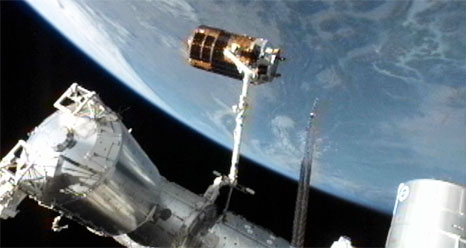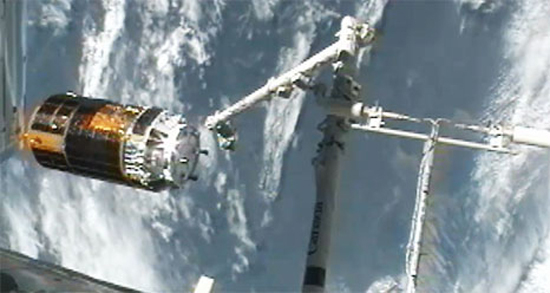Japan's Robotic Cargo Ship Leaves Space Station

Astronauts on the International Space Station bade farewell to a Japanese cargo ship today (Sept. 12), ending Japan's latest delivery flight to the orbiting lab.
Japan's unmanned H-2 Transfer Vehicle 3 (HTV-3) left the space station at 11:50 a.m. EDT (1350 GMT) after station astronauts used a robotic arm to detach the spacecraft from its docking port and set it free. The orbiting lab's robotic arm released the cargo ship, which is now filled with trash and unneeded items, as both spacecraft were sailing 235 miles (378 kilometers) above Canada, NASA officials said.
The HTV-3 spacecraft is expected to be intentionally destroyed early Friday (Sept. 14), when it fires its rocket engines for the last time to leave orbit and burn up in Earth's atmosphere somewhere over the Pacific Ocean. That de-orbit maneuver is scheduled for about 12:50 a.m. EDT (0450 GMT) on Friday, NASA officials said.
Japan's HTV cargo ships are cylindrical vessels capable of hauling tons of supplies and new equipment for astronauts living on the International Space Station. The spacecraft were developed by the Japan Aerospace Exploration Agency and are also called Kounotori, which is Japanese for "White Stork."
Japan launched HTV-3 to the space station on July 20, and the cargo ship arrived at the orbiting laboratory a week later. NASA astronaut Joe Acaba and Japanese astronaut Akihiko Hoshide used the station's robotic arm to capture the craft and attach it to an available docking port. The same two astronauts performed the detach-and-release procedure for HTV-3 today. [Launch Photos for Japan's HTV-3 Spaceship]
The HTV-3 spacecraft delivered nearly 8,000 pounds (3,600 kilograms) of cargo to the space station, including care packages of food, clothes and other gear for the outpost's six-person crew. The cargo ship also delivered an aquatic habitat that will eventually house fish for a future science experiment, two student experiments for a YouTube Space Lab contest, and external experiments that were moved to a porch-like platform on the station's Japanese Kibo laboratory module.
Japan's HTV spaceships are part of an international fleet of unmanned spacecraft used to send regular cargo deliveries to the space station. The fleet includes Russia's Progress spacecraft, Europe's Automated Transfer Vehicles and the private Dragon space capsules built by the private U.S. spaceflight company SpaceX.
Get the world’s most fascinating discoveries delivered straight to your inbox.
SpaceX's first Dragon spacecraft flew a test flight to the space station in May, with the first operational delivery flight scheduled to launch in October. Another American company, the Virginia-based Orbital Sciences Corp., is building an unmanned space cargo ship for NASA called Cygnus. The spacecraft's Antares rocket is expected to make its first test flight later this year.
SpaceX and Orbital Sciences each have contracts with NASA to provide regular cargo delivery flights to the space station.
This story was provided by SPACE.com, a sister site to LiveScience. You can follow SPACE.com Managing Editor Tariq Malik on Twitter @tariqjmalik and SPACE.com on Twitter @Spacedotcom. We're also on Facebook & Google+.

Tariq is the editor-in-chief of Live Science's sister site Space.com. He joined the team in 2001 as a staff writer, and later editor, focusing on human spaceflight, exploration and space science. Before joining Space.com, Tariq was a staff reporter for The Los Angeles Times, covering education and city beats in La Habra, Fullerton and Huntington Beach. He is also an Eagle Scout (yes, he has the Space Exploration merit badge) and went to Space Camp four times. He has journalism degrees from the University of Southern California and New York University.




